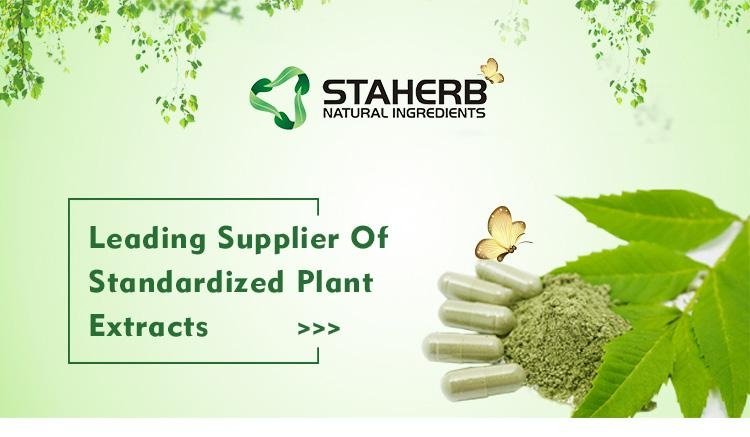
Rosemary extract Carnosic acid
Source:Rosemary leaf extract
Active ingredients:Carnosic acid
Cas No.: 3650-09-7
Molecular formula: C20H28O4
Molecular weight: 332.43
Appearance:yellow powder
Specification:5%-90%
Test Method:HPLC

About Rosemary leaf extract
Rosmarinus officinalis, commonly known as rosemary, is a woody, perennial herb with fragrant, evergreen, needle-like leaves and white, pink, purple, or blue flowers, native to the Mediterranean region,which active ingredients including:Ursolic acid,carnosic acid,rosmarinic acid.
Carnosic acid:
Carnosic aicd is considered to be a natural, efficient and stable (high temperature durable),security, non-toxic and
none-side-effects, oil-soluble antioxidants and a green food additive. It can be added into oil and fatty food, pharmaceutical, chemical, cosmetics and feed, etc.In addition to prevent or delay the oxidation process of oil and fatty food,improve the stability of the food and extend the storage time, and be used as meat and fish sauce, it also has good physical and biological activities,such as antibacterial action, inhibiting the AIDS virus ; Carnosic aicd could effectively control body weight by regulating the absorption of fat, to achieve the goal of reducing weight, it also can treat inflammation, sore throats, and indigestion, prevent alzheimer's disease,it can treatment of diabetes, and to promote the formation of nerve growth factor etc.
| Rosemary Extract |
||||
| Active Ingredients |
Specs |
Test Method |
Appearance |
Solubility |
| Rosmarinic acid |
5-95% |
HPLC |
Brown yellow to yellow powder |
Water soluble |
| Carnosic acid |
5-98% |
HPLC |
Brown yellow to yellow powder |
Oil soluble |
| Carnosic acid (Oil) |
5-20% |
HPLC |
Brown yellow liquid |
|
| Ursolic acid |
5-98% |
HPLC |
Greenish yellow to white |
Water soluble |
| Rosmary essential oil |
|
GC |
Light yellow liquid |
|
| Rosemary Hydrosol |
|
|
|
|
Staherb Carnosic Acid Main Function:
1. Reduce the skin congestion, edema, swelling.
2. Convergence skin, improve dandruff; Relief menorrhalgia, diuresis, weight loss.
3. Good for gastrointestinal, heart, lungs, liver, gallbladder.
4. Cardiac stimulant, fall blood pressure, regulate anemia; Refreshing, refreshment, recover central nervous energy.
5. Using after reducing weight of convergence for skin, it can make the skin more firm and elastic.
Staherb Carnosic Acid Applicaton:
1.Food industry
2.Pharmaceutical and Health Care Industry
3.Cosmetic Industry
For more product information pls contact at email sales09@staherb.cn

References:
1.Cavero S, Jaime L, Martín-Álvarez PJ, Señoráns FJ, Reglero G, Ibañez E (2005) In vitro antioxidant analysis of supercritical fluid extracts from rosemary (Rosmarinus officinalis L.). Eur Food Res Technol 221:478–486
2.Marrero JG, Moujir L, Andrés LS, Montaño NP, Araujo L, Luis JG (2009) Semisynthesis and biological evaluation of abietane-type diterpenes. Revision of the structure of rosmaquinone. J Nat Prod 72:1385–1389
3.Jordán MJ, Lax V, Rota MC, Lorán S, Sotomayor JA (2012) Relevance of carnosic acid, carnosol, and rosmarinic acid concentrations in the in vitro antioxidant and antimicrobial activities of Rosmarinus officinalis(L.) methanolic extracts. J Agric Food Chem 60:9603–9608
4.Nakatani N, Inatani R (1981) Structure of rosmanol, a new antioxidant from rosemary (Rosmarinus officinalis L.). Agric Biol Chem 45:2385–2386
5.Ahmed AA, Mohamed AH, Karchesy J, Asakawa Y (2006) Salvidorol, a nor-abietane diterpene with a rare carbon skeleton and two abietane diterpene derivatives from Salvia dorrii. Phytochemistry 67:424–428
6.Schwarz K, Ternes W (1992) Antioxidative constituents of Rosmarinus officinalis and Salvia officinalis.II. Isolation of carnosic acid and formation of other phenolic diterpenes. Z Lebensm Unters Forsch 195:99–103
7.Zhang Y, Smuts JP, Dodbiba E, Rangarajan R, Lang JC, Armstrong DW (2012) Degradation study of carnosic acid, carnosol, rosmarinic acid, and rosemary extract (Rosmarinus officinalis L.) assessed using HPLC. J Agric Food Chem 60:9305–9314
8.Brieskorn CH, Dömling HJ (1969) Natürliche und synthetische derivate der carnosolsäure. Arch Pharm 302:641–6499
9.Cuvelier ME, Berset C, Richard H (1994) Antioxidant constituents in sage (Salvia officinalis). J Agric Food Chem 42:665–669
10.Richheimer SL, Bernart MW, King GA, Kent MC, Bailey DT (1996) Antioxidant activity of lipid-soluble phenolic diterpenes from rosemary. J Am Oil Chem Soc 73:507–514
11.Wenkert E, Fuchs A, Mcchesney JD (1965) Chemical artifacts from the family Labiatae. J Org Chem 30:2931–2934
12.Masuda T, Inaba Y, Takeda Y (2001) Antioxidant mechanism of carnosic acid: structural identification of two oxidation products. J Agric Food Chem 49:5560–5565
13.Masuda T, Inaba Y, Maekawa T, Takeda Y, Tamura H, Yamaguchi H (2002) Recovery mechanism of the antioxidant activity from carnosic acid quinone, an oxidized sage and rosemary antioxidant. J Agric Food Chem 50:5863–586
14.Inatani R, Nakatani N, Fuwa H, Seto H (1982) Structure of a new antioxidative phenolic diterpene isolated from rosemary (Rosmarinus officinalisL.). Agric Biol Chem 46:1661–1666
15.Nobuji N, Inatani R (1984) Two antioxidative diterpenes from rosemary (Rosrnarinus officinalisL.) and a revised structure for rosmanol. Agric Biol Chem 48:2081–2085 Masuda T, Inaba Y, Takeda Y (2001) Antioxidant mechanism of carnosic acid: structural identification of two oxidation products. J Agric Food Chem 49:5560–5565